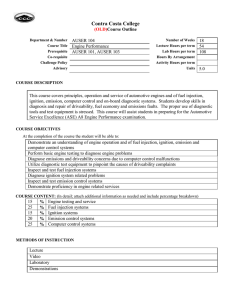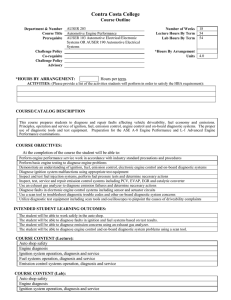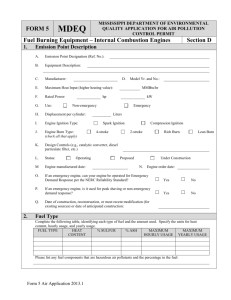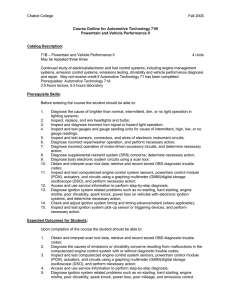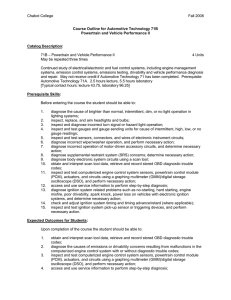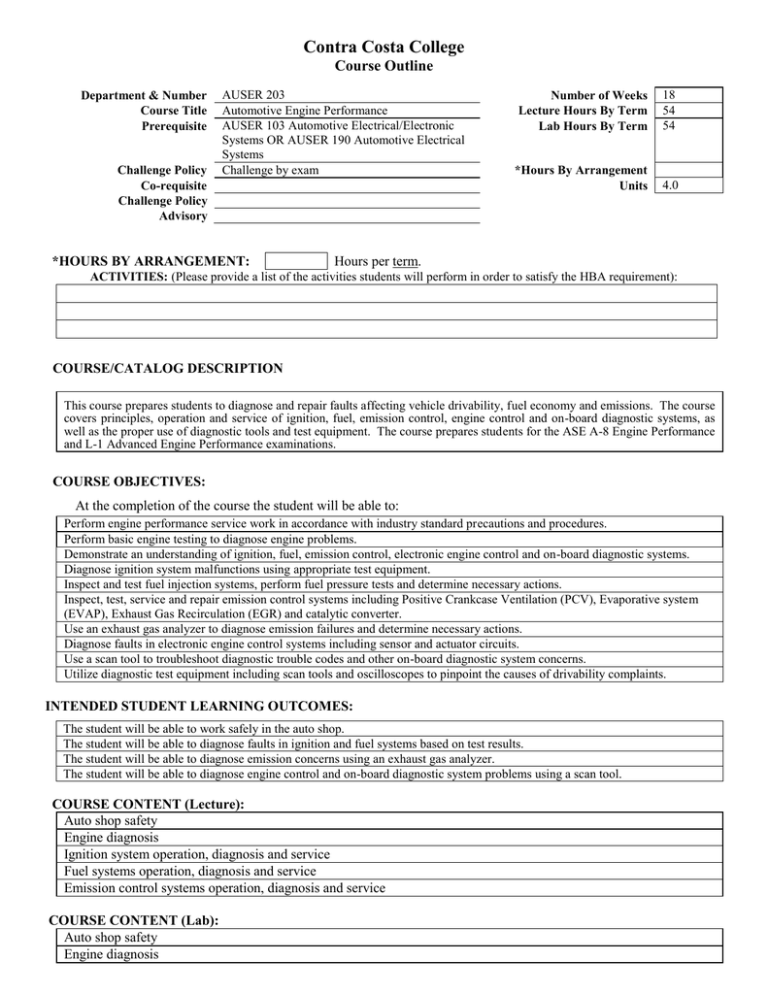
Contra Costa College
Course Outline
Department & Number
Course Title
Prerequisite
Challenge Policy
Co-requisite
Challenge Policy
Advisory
AUSER 203
Automotive Engine Performance
AUSER 103 Automotive Electrical/Electronic
Systems OR AUSER 190 Automotive Electrical
Systems
Challenge by exam
*HOURS BY ARRANGEMENT:
Number of Weeks
Lecture Hours By Term
Lab Hours By Term
18
54
54
*Hours By Arrangement
Units
4.0
Hours per term.
ACTIVITIES: (Please provide a list of the activities students will perform in order to satisfy the HBA requirement):
COURSE/CATALOG DESCRIPTION
This course prepares students to diagnose and repair faults affecting vehicle drivability, fuel economy and emissions. The course
covers principles, operation and service of ignition, fuel, emission control, engine control and on-board diagnostic systems, as
well as the proper use of diagnostic tools and test equipment. The course prepares students for the ASE A-8 Engine Performance
and L-1 Advanced Engine Performance examinations.
COURSE OBJECTIVES:
At the completion of the course the student will be able to:
Perform engine performance service work in accordance with industry standard precautions and procedures.
Perform basic engine testing to diagnose engine problems.
Demonstrate an understanding of ignition, fuel, emission control, electronic engine control and on-board diagnostic systems.
Diagnose ignition system malfunctions using appropriate test equipment.
Inspect and test fuel injection systems, perform fuel pressure tests and determine necessary actions.
Inspect, test, service and repair emission control systems including Positive Crankcase Ventilation (PCV), Evaporative system
(EVAP), Exhaust Gas Recirculation (EGR) and catalytic converter.
Use an exhaust gas analyzer to diagnose emission failures and determine necessary actions.
Diagnose faults in electronic engine control systems including sensor and actuator circuits.
Use a scan tool to troubleshoot diagnostic trouble codes and other on-board diagnostic system concerns.
Utilize diagnostic test equipment including scan tools and oscilloscopes to pinpoint the causes of drivability complaints.
INTENDED STUDENT LEARNING OUTCOMES:
The student will be able to work safely in the auto shop.
The student will be able to diagnose faults in ignition and fuel systems based on test results.
The student will be able to diagnose emission concerns using an exhaust gas analyzer.
The student will be able to diagnose engine control and on-board diagnostic system problems using a scan tool.
COURSE CONTENT (Lecture):
Auto shop safety
Engine diagnosis
Ignition system operation, diagnosis and service
Fuel systems operation, diagnosis and service
Emission control systems operation, diagnosis and service
COURSE CONTENT (Lab):
Auto shop safety
Engine diagnosis
Ignition system operation, diagnosis and service
Fuel systems operation, diagnosis and service
Emission control systems operation, diagnosis and service
METHODS OF INSTRUCTION:
Shop Work
Lecture
Discussion
Demonstrations
On-line training (Online Safety and Pollution course and test)
INSTRUCTIONAL MATERIALS:
NOTE: To be UC/CSU transferable, the text must be dated within the last 7 years OR a statement of justification for a text beyond the
last 7 years must be included.
Textbook Title:
Author:
Publisher:
Edition/Date:
Textbook Reading Level:
Justification Statement:
Automotive Technology: Principles, Diagnosis, and Service
James D. Halderman
Pearson Prentice Hall
Fourth Edition / 2012
(For textbook beyond 7 years)
Lab Manual Title (if applicable):
Author:
Publisher:
Edition/Date:
OUTSIDE OF CLASS WEEKLY ASSIGNMENTS:
Title 5, section 55002.5 establishes that a range of 48 -54hours of lecture, study, or lab work is required for one unit of credit.
For each hour of lecture, students should be required to spend an additional two hours of study outside of class to earn one
unit of credit.
State mandates that sample assignments must be included on the Course Outline of Record.
Outside of Class Weekly Assignments
Hours per week
Weekly Reading Assignments (Include detailed assignment below, if applicable)
2
Read chapter on ignition system components and operation.
Weekly Writing Assignments (Include detailed assignment below, if applicable)
2
Complete “Review Questions” and “Chapter Quiz” on ignition system components and operation
Weekly Math Problems (Include detailed assignment below, if applicable)
Lab or Software Application Assignments (Include detailed assignment below, if applicable)
Online safety and pollution assignments and test found at www.sp2.org.
Other Performance Assignments (Include detailed assignment below, if applicable)
2
STUDENT EVALUATION: (Show percentage breakdown for evaluation instruments)
Course must require use of critical thinking, college-level concepts & college-level learning skills.
For degree credit, course requires essay writing unless that requirement would be inappropriate to the course objectives. If writing
is inappropriate, there must be a requirement of problem-solving or skills demonstration.
25
50
25
%
Essay (If essay is not included in assessment, explain below.)
%
%
%
Computation or Non-computational Problem Solving Skills
Skills Demonstration
Objective Examinations
Other (describe)
%
%
%
GRADING POLICY: (Choose LG, P/NP, or SC)
Letter Grade
90% - 100% = A
80% - 89% = B
70% - 79% = C
60% - 69% = D
Below 60% = F
Pass / No Pass
70% and above = Pass
Below 70% = No Pass
Prepared by: Lucile Beatty
Date: 3/22/14
Revised form 01/14
x
Student Choice
90% - 100% = A
80% - 89% = B
70% - 79% = C
60% - 69% = D
Below 60% = F
or
70% and above = Pass
Below 70% = No Pass

